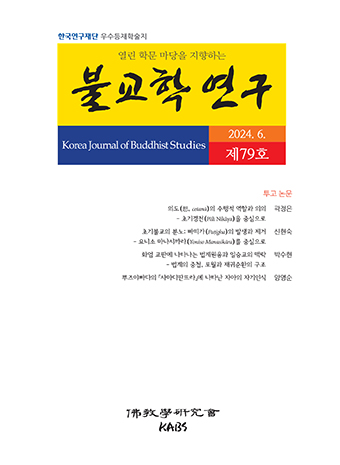Abstract
References
Sorry, not available.
Click the PDF button.
Information
This article tried to understand both the motive of occurrence of Madhyamika Philosophy and the motive of Nagarjuna’s critique on the Realism of Schola Buddhism, from standpoint of the continuity and discontinuity of Middle Way conception. In order to catch out the continuity and discontinuity of the conception of Middle Way, this study compared the conception of Middle Way in Early Buddhism with that of Schola Buddhism and of Nagarjuna. In Early Buddhism, the Middle Way was generally used in four conceptions; the Pain-Pleasure Middle Way, the Being-Non-being Middle Way, the Sameness-Difference Middle Way, and the Eternity-Extinction Middle Way. But the scholars of Schola Buddhism understood the Middle Way of the Buddha through two conceptions of the Pain-Pleasure Middle Way and the Eternity- Extinction Middle Way. When we compared the conception of Middle Way in Early Buddhism with that of Schola Buddhism and of Nagarjuna, we can know that the Realism of Schola Buddhism implies the cutting and discontinuity of the Being-Non-being Middle Way and the Eternity-Extinction Middle Way of the Early Buddhism, but Nagarjuna’s Madhyamika Philosophy implies the restoration and continuity of the Being- Non-being Middle Way, the Sameness-Difference Middle Way, and the Eternity- Extinction Middle Way of Early Buddhism. Nagarjuna proved that only when we admit that all things are the Middle Way, the basic teachings of the Buddha and the moral customs of people can be correctly established. From this, we can understand the motive of occurrence of Madhyamika Philosophy and the motive of Nagarjuna’s critique on the Realism of Schola Buddhism from a new perspective. In short, the motive of occurrence of Madhyamika Philosophy and the motive of Nagarjuna’s critique on the Realism of Schola Buddhism were the restoration of basic teachings of the Buddha and moral customs of people through the restoration of Middle Way theory.
논자는 본 연구에서 불타, 부파불교, 그리고 용수의 중도설을 비교하여 중도 개념의 불연속성과 연속성을 파악함으로써, 중관사상의 발생 동기 및 용수의 부파불교 법유론 비판 동기를 중도 개념의 불연속성과 연속성이라는 측면에서 파악해 보고자 하였다. 본 연구에서 살펴본 내용을 요약하면 다음과 같다. 불타는 중도를 고락중도, 유무중도, 일이중도, 단상중도 등의 의미로 사용하였지만, 부파불교의 논사들은 불타의 중도설을 고락중도와 단상중도를 중심으로 이해하였다. 불타, 부파불교, 그리고 용수의 중도설을 비교해보면 다음과 같은 사실을 알 수 있다. 부파불교의 법유론은 불타가 설했던 유무중도와 단상중도의 단절과 불연속성을 함축한다. 그러나 용수의 중관사상은 불타가 설했던 유무중도 및 일이중도와 단상중도의 복원과 연속성을 함축한다. 용수는 그 밖에도 부파불교의 법유론이 불타의 중도설만이 아니라, 사성제, 연기, 삼법인 등과 같은 불타의 근본 가르침과 세간의 도덕 관습들을 모두 올바르게 설명할 수 없으며, 오직 일체법이 연기이고, 무자성, 공, 가명, 중도임을 승인할 때에만 비로소 불타의 근본 가르침과 세간의 도덕 관습이 모두 올바르게 성립할 수 있음을 논증하였다. 이와 같은 고찰로부터 중관사상의 발생 동기 및 용수의 부파불교 법유론 비판 동기를 새로운 측면에서 이해할 수 있다. 요컨대 중관사상의 발생 동기 및 부파불교 법유론에 대한 용수의 비판 동기는 불타의 중도설 복원을 통한 불타의 근본 가르침 및 세간적 도덕 관습의 복원이었던 것이다.
Click the PDF button.
- Publisher :Korean Association of Buddhist Studies
- Publisher(Ko) :불교학연구회
- Journal Title :Korea Journal of Buddhist Studies
- Journal Title(Ko) :불교학연구
- Volume : 50
- No :0
- Pages :27~57


 Korea Journal of Buddhist Studies
Korea Journal of Buddhist Studies






